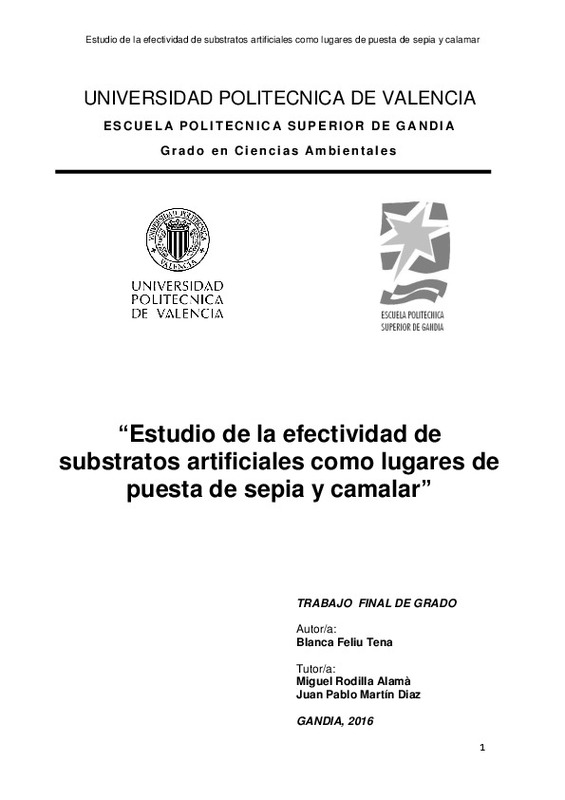JavaScript is disabled for your browser. Some features of this site may not work without it.
Buscar en RiuNet
Listar
Mi cuenta
Estadísticas
Ayuda RiuNet
Admin. UPV
Estudio de la efectividad de substratos artificiales como lugares de puesta de sepia y calamar
Mostrar el registro sencillo del ítem
Ficheros en el ítem
| dc.contributor.advisor | Rodilla Alamá, Miguel
|
es_ES |
| dc.contributor.advisor | Martín Díaz, Juan Pablo
|
es_ES |
| dc.contributor.author | Feliu Tena, Blanca
|
es_ES |
| dc.date.accessioned | 2016-09-05T14:52:41Z | |
| dc.date.available | 2016-09-05T14:52:41Z | |
| dc.date.created | 2016-07-12 | |
| dc.date.issued | 2016-09-05 | es_ES |
| dc.identifier.uri | http://hdl.handle.net/10251/68761 | |
| dc.description.abstract | Las capturas pesqueras de cefalópodos se han incrementado a nivel global. Los pescadores artesanales de Gandia explotan un “metier” de sepia capturada con trasmallo. Las capturas de esta pesquería han oscilado considerablemente de un año a otro y se percibe un descenso en capturas en el último periodo. En la gestión de las pesquerías de cefalópodos se plantea incrementar los hábitats que favorecen las puestas, puesto que la mayoría de las capturas por pesca artesanal se asocian a los hábitos y periodo reproductor. En este trabajo, se evalúa el efecto de substratos artificiales para favorecer la puesta de sepia (Sepia officinalis) y calamar (Loligo vulgaris y Loligo forbesi) sobre arenas, la influencia batimétrica y la posibilidad de recuperar las puestas que han sido fijadas en artes de pesca y que habitualmente se perderían. Los resultados muestran que es factible recuperar los huevos fijados en las redes e incrementar el éxito reproductor de las especies. Hay preferencia de los calamares por substratos más profundos, superiores a 10 metros, mientras que la sepia utiliza los más superficiales hasta -10 m. La sepia utiliza los substratos más complejos, mientras que los calamares utilizan substratos sencillos, siendo útiles las boyas de profundidad. | es_ES |
| dc.description.abstract | Fishing catches of cephalopods have been increasing during the last years globally. The artisanal fishermen from Gandía operate a “metier” that corresponds to the catches of cuttlefish throughout driftnet. Catches by these fisheries have fluctuated significantly from one year to another and it has been perceived a decrease of catches in the last period. People responsible of the management of the fishing cephalopods are considering increasing the habitats that favour their spawning because the majority of the catches by artisanal fisheries are associated to the habitats and the reproductive period of these species. On this project, it has been evaluated the effects of the artificial substrates that stimulate the spawning of cuttlefish (Sepia officinalis) and squid (Loligo vulgaris and Loligo forbesi) on sandy bottoms. In addition, it has been also studied the influence of bathymetry on these substrates and the possibility of recovering the spawning that has been fixed on driftnets and it would be thrown out. The results have shown that it is possible to recover the eggs fixed on driftnets and to increase the reproductive success of these species. The squids prefer substrates on major depths, among 10 meters and more deep zones. The cuttlefishes prefer superficial depths, 10 meters maximum. The substrates used by cuttlefishes are more complex, while squids need simpler substrates for which are useful the deep buoy | es_ES |
| dc.format.extent | 50 | es_ES |
| dc.language | Español | es_ES |
| dc.publisher | Universitat Politècnica de València | es_ES |
| dc.rights | Reserva de todos los derechos | es_ES |
| dc.subject | Sepia officinalis | es_ES |
| dc.subject | Gestión pesquera | es_ES |
| dc.subject | DACs. | es_ES |
| dc.subject | Substratos artificiales | es_ES |
| dc.subject | Fisheries management | es_ES |
| dc.subject.classification | TECNOLOGIA DEL MEDIO AMBIENTE | es_ES |
| dc.subject.other | Grado en Ciencias Ambientales-Grau en Ciències Ambientals | es_ES |
| dc.title | Estudio de la efectividad de substratos artificiales como lugares de puesta de sepia y calamar | es_ES |
| dc.type | Proyecto/Trabajo fin de carrera/grado | es_ES |
| dc.rights.accessRights | Abierto | es_ES |
| dc.contributor.affiliation | Universitat Politècnica de València. Instituto de Investigación para la Gestión Integrada de Zonas Costeras - Institut d'Investigació per a la Gestió Integrada de Zones Costaneres | es_ES |
| dc.contributor.affiliation | Universitat Politècnica de València. Departamento de Ingeniería Hidráulica y Medio Ambiente - Departament d'Enginyeria Hidràulica i Medi Ambient | es_ES |
| dc.contributor.affiliation | Universitat Politècnica de València. Escuela Politécnica Superior de Gandia - Escola Politècnica Superior de Gandia | es_ES |
| dc.description.bibliographicCitation | Feliu Tena, B. (2016). Estudio de la efectividad de substratos artificiales como lugares de puesta de sepia y calamar. Universitat Politècnica de València. http://hdl.handle.net/10251/68761 | es_ES |
| dc.description.accrualMethod | TFGM | es_ES |
| dc.relation.pasarela | TFGM\45619 | es_ES |
Este ítem aparece en la(s) siguiente(s) colección(ones)
-
EPSG - Trabajos académicos [4726]
Escuela Politécnica Superior de Gandia






